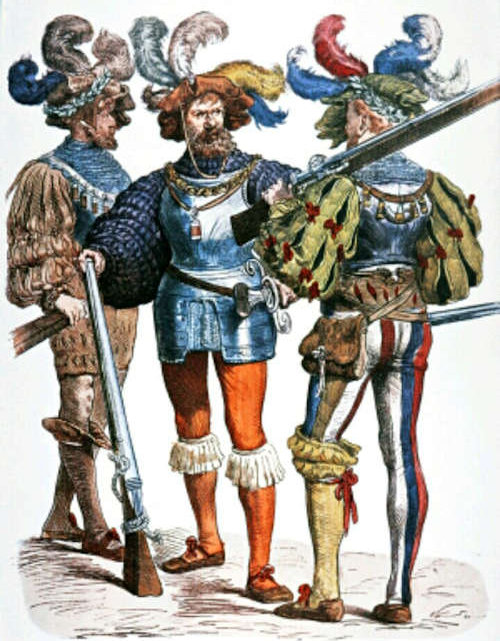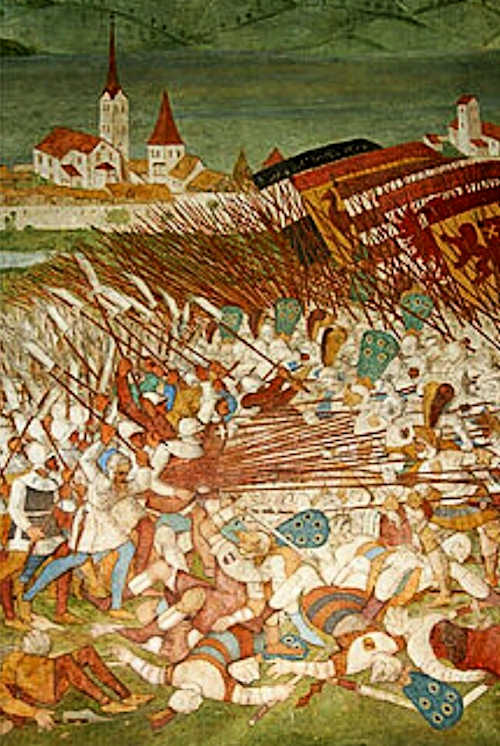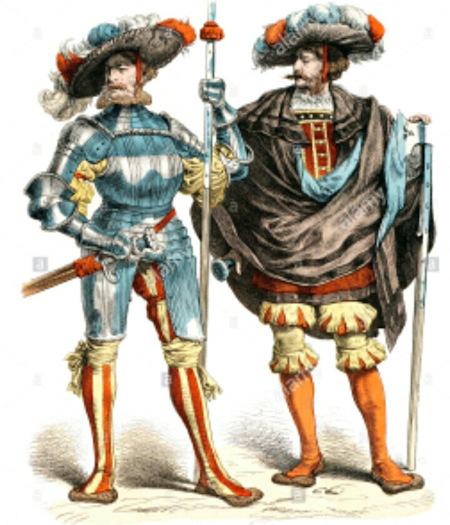Between the 1494 and the 1529 Italy was ravaged by what are known as the 'Wars of Italy'.
On the one hand the French of Francis I, on the other the Spaniards of Charles V, both wanted to extend their dominions in Italy. Sources tell us that the "Italians", divided as always, sided with one faction or the other depending on the situation (which could change overnight!). The alliances were therefore somewhat tenuous.
From a historic point of view, but especially war, this period is a definitive step: the sunset of the Middle Ages and its way of understanding war and fighting it.
The key to understanding lies in the ideological differences of the two sides. Class disparity between knights and infantrymen in French forces, still distant from each other socially and militarily, distinct and separate, all exacerbated by envy, lack of cooperation, distrust and low mutual esteem.
In the Spanish lineup, knights and footmen begin a closer collaboration. They support each other, help each other, help each other, appreciate each other.
Sources report that infantrymen often climbed behind the saddle of a knight who spontaneously gave him a 'ride' to the points where they had to line up with the other infantry, or that a noble was on foot, "infantryman" too!
The French still enthusiastic for the heavy cavalry carried frontally left the infants as support or in almost always secondary roles and still armed almost exclusively with white weapons.
The Spanish infantrymen instead began to introduce arquebuses and muskets as armament then, together with other firearms, cannons, falconets and other artillery. Instead of the frontal attack, they preferred a sort of guerrilla warfare: protected by the natural roughness of the ground, they dug trenches and raised palisades and mounds of earth to hide and surprise the enemy from the side, from behind or with crossfire.

The French refused to compromise with this combat system, feeling it "villainous". In the frontal charge they often found themselves losing a lot of the actual, shot down by firearms. Too heavy, too slow and with armor that can not withstand bullets, especially if it explodes at close range or on horses.
Another example of their mental anachronism is the choice of mercenaries: the French had Swiss at their side who were able to face the enemy while maintaining their ranks even at the price of very high losses, never abandoned the ground and rarely fled. The sources hand down descriptions of battles where the Swiss advanced in line trampling on their fallen comrades and defeating the enemy frightened by this attitude, for this reason they were considered fearsome and invincible. Equipped with spades about 6 meters long, they formed rather tight squares and difficult to disperse or break.
Towards the end of the fifteenth century the landsknechts. Very similar but more striking in the way of dressing than the Swiss (also from the clothing you can see how much the Germans were inspired by the Swiss in forming this new type of infantry), in a few decades they will become enemies par excellence. The only exception i black lanzecenecchi that, in spite of the oath that every 'servant of the earth' or 'homeland' precisely 'Land Knecht' was required to make already at the time of Maximilian I (their 'inventor' in 1487) or to never side with the enemies of 'Spanish / German emperor, there will always be at the side of the Swiss and recruited from France.
Considered traitors for this, they will always be massacred and never made prisoners, whenever beaten by their compatriots.
While the lansquenets will evolve, thanks also to the Marquis of Pescara with his innovative fighting ideas, the Swiss will still remain together with the French anchored to a medieval and now anachronistic fighting system. The use of firearms will become increasingly popular among the lansquenets, the Swiss will be much more reluctant to tackle these innovations. This will cost them and the French a high human toll in lives and especially of defeats on the field.

Marignano, Bicocca, Pavia, Governolo, the Sack of Rome ... by now the Spaniards together with the Germans had become unstoppable. It is no coincidence that it was said that on the reign of Charles V never sunset his domains were so wide. Firearms and new combat systems had begun to determine the outcome of the battles.
Usually after the initial cavalry charge of breakthrough by the French, the two infantry - the Swiss and the lansqueneck - faced each other with the use of enormous pikes, but the Germans had also adopted a large two-handed sword (roughly between 4 and 6 kg of weight), the 'doppelsoldner' or 'double penny', so called because whoever was in possession of it received double pay compared to another infantryman, with whom they hit, shattering the pikes and therefore the opposing ranks.
Among these men, also lined up with pikes, took place arquebusiers, crossbowmen and infantry armed with ax. All were equipped with the 'katzbalger' or 'squarta cats', a short sword similar to a gladius but more rounded at the tip, well manageable, weighing about a kilo and a half, so called because the sheath was often covered with fur cat. But someone says that they used it on a cat to try it ... You will find it in every iconography tied to the waist almost horizontally, in front of or behind the bust of the soldier. Unsheathed and used once in close contact with the enemy it was an excellent weapon in the melee.
The firearms were meant to start a clash that almost ended with the use of white weapons.
The Swiss and the Germans were poor and purely mountain peoples, with massive bodies and natures, hardened by cold and deprivation, this made them excellent soldiers once trained. At home they had no economic means to live, the war represented the possibility of making booty. This hope encouraged the desire to enlist and Italy was considered a very rich land ... as testified by all our cities plundered by these ranks.
According to the sources, it seems that it took decades before succeeding in restoring the economy that had been destroyed during the 1527 Sack of Rome.












